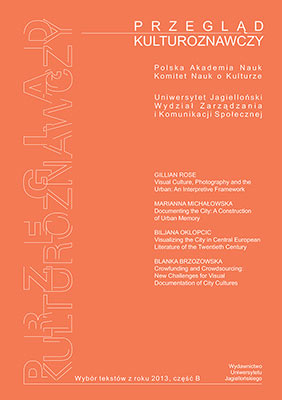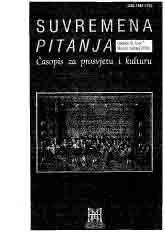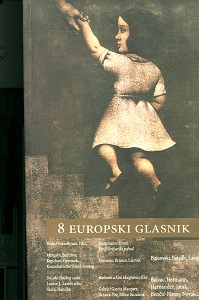We kindly inform you that, as long as the subject affiliation of our 300.000+ articles is in progress, you might get unsufficient or no results on your third level or second level search. In this case, please broaden your search criteria.

This article offers a framework for understanding and refl ecting upon the various ways that urban scholars have worked with visual representations of city spaces. It suggests that there are three main approaches: representing the urban, evoking the urban and performing the urban. The paper discusses the methodological implications of each of these.
More...
By exploring the cliché that socialist cities are ‘grey’, this paper seeks to employ the anthropology of colour for unravelling the peculiarities of the East European urban experience. By analyzing the oeuvre of Władysław Reymont, I show that greyness in Eastern Europe has a distinct lineage. It is not, like in the West, a colour poised between black and white, but the very opposite of red. I show how greyness emerged as the central trope for narrating Polish agrarian capitalism, and how after 1945 it was moved onto the urban turf. Greyness became salient because it captured the very essence of the contradictions of nascent urban Poland: a blend of freedom and oppression, equality and hierarchy, solemnity and joy. I describe these conflicting meanings of greyness and show how colour suddenly became the fulcrum of the struggle to generate an urban experience beyond capitalism and socialism that would be East European and cosmopolitan at the same time.
More...
Kwestie wzajemnych relacji oraz powiązania i oddziaływania na siebie sfer technologii i kultury stają się coraz istotniejszym przedmiotem refl eksji kulturoznawców i medioznawców. Śledząc polskie publikacje z tej dziedziny z ostatnich lat, wypada zauważyć, że problematyka ta jest omawiana wielostronnie i w gruncie rzeczy odzwierciedla główne dylematy i pytania badawcze, istotne dla tak właśnie zarysowanej problematyki. Z pewnością jedną z bardziej wartościowych inicjatyw badawczych, które pojawiły się w Polsce w tym obszarze, jest Interdyscyplinarne Centrum Badawcze HAT (Humanities/Art/Technology) na Uniwersytecie im. Adama Mickiewicza w Poznaniu. Centrum zostało powołane w 2011 roku, a głównym jego celem – jak czytamy w deklaracji programowej HAT – „jest prowadzenie i inicjowanie nowatorskich projektów, które realizują ideę synergicznej współpracy pomiędzy specjalistami różnych dziedzin z zakresu nauki, technologii i sztuki”.
More...

The article presents functional, spatial and symbolic transformations of New York City and its architecture after the terrorist attack of 9/11. Destroyed Twin Towers have been replaced by the new WTC One, highest building in the US. Its architecture is controversial, but according to author, it will soon became a new symbol of New York. 9/11 tragedy did not stop development of the city. Just contrary: New York’s ambition is to become a model for cities in the 21st century, a resident-friendly and sustainable urban eco-system.
More...
The text deals with an issue of reading images as a way of perceiving the osmosphere. The author observes that eyesight might enhance other sensory modalities, provided that the eye no longer is isolated from natural interaction with the environment which has olfactory properties, but also audio and haptic. The analysis is related to two possibilities of reasoning about smells based on visual data. In the first case, the photograph appeals to the olfactory memory and serve as a tool to elicit a narration on scents from a person. In the second case, the use of the olfactory imagination seems to be necessary as a sort of subconscious for the hegemonic eye. The image an individual can see evokes internal representations, which should be taken into account when analysing and interpreting the urban space.
More...
Olja Triaška Stefanovič (1978) was born in Novi Sad, Serbia, lives and works in Bratislava, Slovakia. In 2007 she graduated from the Academy of Fine Arts and Design at the Department of Photography and New Media in Bratislava, Slovakia. In her art practise she is focused on the relationship between photography and space, historical and sociological memory space, the disappearance of space, but also changes of its functionality and space simulation. For last four years she works at the Department of Photography and New Media and this year finishing her doctoral studies of photography at the Academy of Fine Arts and Design in Bratislava. She was presenting her work at many group and solo exhibitions in Slovakia, Czech Republic, Serbia, Spain, Germany.
More...
Based on the BA thesis Urban Spaces of Motion Pictures: Modern Architecture in the Perspective of Audiovisual Studies, this paper explores the links between architecture and cinema. My goal is not only to show some theoretical concepts regarding this topic (including ones by Sergei Eisenstein, Walter Benjamin and Jean Baudrillard), but also, and primarily, to study the actual effect which the cinematic perception has on the fi eld of modern architecture. Therefore, I analyse two projects of Rem Koolhaas (Embassy of the Netherlands in Berlin and ZKM in Karlsruhe) in the perspective of audiovisual studies. In my analyses, I examine such notions as “the narrativity of architecture” and “the architectural media screen”, using some methodological tools borrowed from the field of film studies.
More...
Interview with Nicolaus Sombart. N. Sombart explaind the importance of the influence the context in which he grew up had upon him ans his works.
More...
Jedanaesto Mostarsko proljeće počelo je spektakularno, upravo onako kako i dolikuje manifestaciji njegova ranga, nadomak prijamu u FA-u, najstariju asocijaciju europskih festivala. Počelo je dvjema reprezentativnim izložbama, a nastavljeno gala-koncertom "Sarajevo na Mostarskom proljeću" kojim je obilježena 35. obljetnica umjetničkoga djelovanja Ivice Šarića.
More...
U organizaciji Matice hrvatske Prozor - Rama u Prozoru je predstavljen časopis Suvremena pitanja. Promocija je održana u dvorani Elektroprivrede Hrvatske zajednice Herceg-Bosne pred oko 80-ak nazočnih. O Časopisu su govorili predsjednik MH Prozor- Rama prof. Šimun Novaković, prof. josip Grubeša, obojica asistenti na Filozofskome fakultetu u Mostaru, mr. Stipe Ivanković iz Mostara te glavni urednik časopisa Ivan Sivrić. Moderatorica je bila Tina Čović, profesorica iz Mostara.
More...
ln contrast to the former policy that was founded on the solution of already arisen problems in the field of environment protection, today' s environmental policy in developed countries, especially in EU member countries, is based on the princip/es of . sustainable development, that is on the integration of environment protection policy in all sectors along with the promotion of the princip/e of shared responsibility. Therefore the key guide/ine in defining our strategic targets is the accommodation of our society to the concept and philosophy of sustainable development. Moreover, having in mind the fact that Bosnia and Herzegovina has decided for the process of stabilisation and association with the European Union, the strategies for the protection of the environment in the Federation of Bosnia and Herzegovina and at other levels will play one of the key roi es on this road, given that the environment sector is a highly positioned priority of the Union. lt is beyond dispute that human resources constitute a great value of the Federation BiH, which unfortunately has not been systematically included in the environment protection p roce ss es. The reasons for that are to be look ed for in the fact that environment problems are very little taught about in our schools, while environmental education is a/most nonexistent. Even most university institutions that study pu blic policies, consider it no social problem at all if in the course of study the environment policy and the environment management system are not studied. And the acquisition of knowledge about environment is the first step towards the solution of the environment problem. The federal strategy of environmental protection provides for the construction of a basic educational system targeted at the coming generations that might give an important contribution to the overall awareness of the need to p reserve the environment, and by means of these processes reduce the risk of lasting damages to the environment. lt is a long and expensive process that demands the engagement of the whole social community, butthis process has no alternative.
More...
The paper describes the masking and carnival customs in Hutovo. The paper gives the ethnographic and folklore background, and describes the peculiarities in staging masquerades and carnivals in Neum and at the International Carnival in Čapljina.
More...
Dvojica bosanskohercegovačkih nobelovaca, Ivo Andrić i Vladimir Prelog, uskoro bi u Mostaru trebali dobiti svoj spomenik. Kao što je poznato, Matica hrvatska dosad je postavila brojne spomenike u gradu na Neretvi, počevši od spomen-ploče u školi Silivija Strahimira Kranjčevića, zatim spomenika akademiku l. Zovki, l. Jakovljeviću, M. Maruliću, kraljici Katarini, A. B. Šimiću i još deset spomenika koji su ostavljeni gradu u sklopu likovne kolonije koja je bila organizirana za vrijeme minulih Dana Matice hrvatske u Mostaru.
More...
When the heated debate, conducted for decades about the theory of evolution, seemed to be abating giving way to an elegant compromising attitude that it was possible to reconcile the two seemingly irreconcilable views of how life came to be and developed on the Earth, a new theory appeared called "intelligent design", which tries to scientifically challenge Darwinist propositions, and to prave that the cause of the overall reality is an intelligent factor rather than a headless coincidence. This paper presents the main objectiom that the advocates of the new view raise against the selection theory. These objectiom point to the short coming of transient species and to the wrong interpretation of certain Jossi/ remains as well as to exaggerated attachment of importance to the mutations itl the evolutionary process, to the inappropriate assertions about the homology of organs among different species, and to the consequences caused by social Darwinism and evolutionary ethics. The paper continues to set forth the key arguments for the intelligent design, and the basic objections raised against it.
More...
Danas sam se vratio ovome sada okrutnom kraju. Našem kraju, oče. I sve kao da se nastavlja. Preda mnom pometene ulice, od svjetla potamnjelo sunce čisti kuće, izbjeljuje vapno; i ožalošćeno vrijeme, zaustavljeno vrijeme, ožalošćeno vrijeme i mnogo tužnije no kada su tvoje oči, jasne od magle i dalekog svježeg vonja mora, gutale ovo sada okrutno svjetlo, kada su tvoje oči govorile glasno, a svijet nije želio ništa više nego tek postojati. I, u međuvremenu, kao da se sve nastavlja. Nabujala tišina, život okrutan samo zato jer je život. [.......]
More...
»Cijeli Beograd«, tako otprilike piše Le Monde, ili neke druge suvremene vodeće svjetske novine, navodno se smijao kada je supruga Slobodana Miloševića, koji je u to vrijeme još bio istražni zatvorenik u zatvoru svoga glavnoga grada, nakon jednog od svojih prvih posjeta mužu izjavila da joj se »Slobodan« učinio »tako lijep«. Ili je gospo|a Mira Marković to izjavila tek kasnije, poslije premještanja bivšega srpskog, a zatim jugoslavenskoga predsjednika iz njegove beogradske ćelije u nizozemsku Kraljevsku kaznionicu u haaškoj četvrti Scheveningen? Da joj se njezin muž nije činio nikada »ljepšim« nego »u zatvorskoj ćeliji «, daleko od svoje Srbije i/ili Jugoslavije. [.......]
More...
DANIEL LINDENBERG: Poziv na red (Istraživanje o novim reakcionarima) integralni rukopis Manifest za slobodnu misao (A. Finkielkraut, M. Gauchet, P. Manent, P. Muray, P.-A. Taguieff, S. Trigano, P. Yonnet) Philippe Muray 2002. (Michel Houellebecq) Novi reakcionari? (Jacques Julliard) Budite hladnokrvni! (Bernard-Henri Lévy) Uključivanje intelektualnoga polja u politički napon (Jacques Donzelot) Lindenberg, teatar reakcija (Alain Bergounioux) Pasolini razbija obrazac »novog reakcionara« (Emmanuel Poncet) »Kategorija Šreakcionarnog’ je fiktivna« (razgovor s A. Finkielkrautom) Zašto treba čitati i braniti Daniela Lindenberga DANIEL LINDENBERG: Call for turn (Research about new reactionists) Manifesto for free thought (A. Finkielkraut, M. Gauchet, P. Manent, P. Muray, P.-A. Taguieff, S. Trigano, P. Yonnet) Philippe Muray 2002. (Michel Houellebecq) New reactionists? (Jacques Julliard) Be coldblooded! (Bernard-Henri Lévy) Inclusion of intelectual field in political circuit (Jacques Donzelot) Lindenberg, theatre of reaction (Alain Bergounioux) Pasolini breaks the cliche of «new reactionist» (Emmanuel Poncet) »Category of reactionary is fictional» (Reply to A. Finkielkrautom) Why should we read and defend (Daniel Lindenberg)
More...